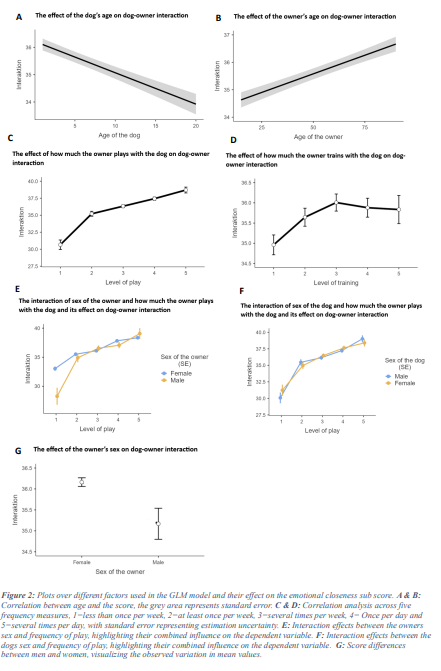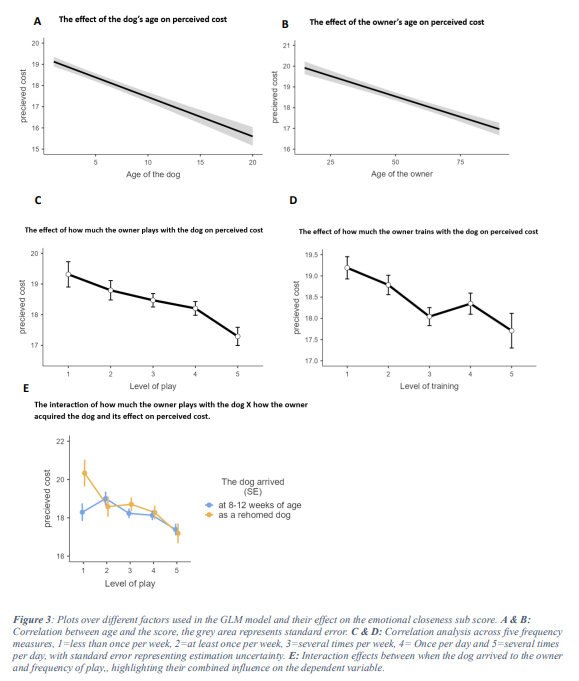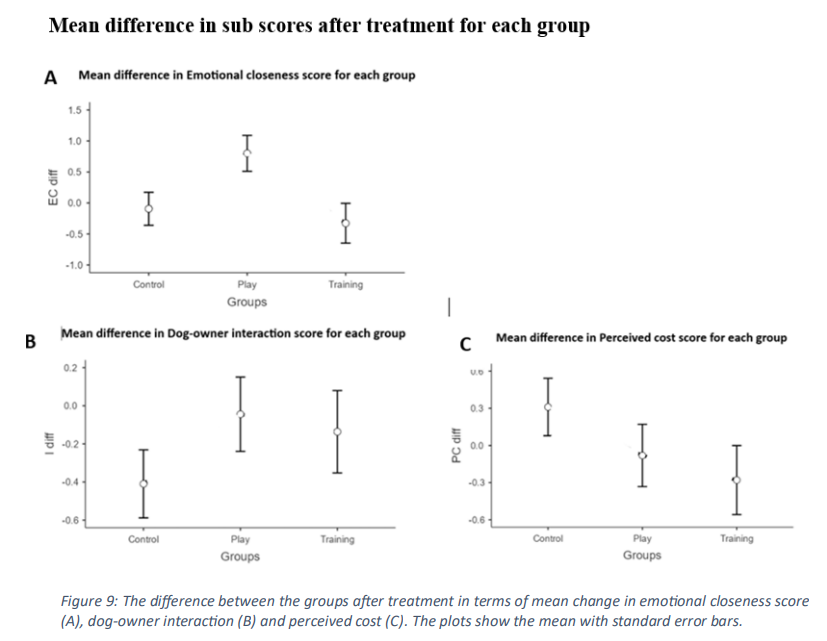1. Survey
Emotional closeness:
The dogs age (B=0.234, P < 0.001) and how much the owner played with the dog were the strongest predictors for the MDORS sub score emotional closeness (X2 (4) =51.28, P < 0.001) with both showing a positive correlation.
Age of the owner showed a significant negative corelation to emotional closeness (B= -0.017, P=0.041) (Fig 1.B) and women scored significantly higher than men (X2 (1) = 5.54, P=0.019) (Fig 1.G). How much the owner trained with their dog only showed a tendency at being linked to emotional closeness (X2 (4) =9.46, P=0.051; Fig 1.D), but had a significant interaction with play (X2 (16) =36.87, P=0.002).

Dog-owner interaction:
The MDORS sub score of Dog-owner interaction was negatively affected by the dog’s age (B= -0.115, P<0.001; Fig. 2A), positively affected by the age of the owner (B= 0.027, P<0.001; Fig. 2B) and women scored significantly higher than men (X2 (1) = 7.02, P=0.008; Fig. 9I). Both how much the owners played with their dog (Fig 2.C) (X2 (4) = 125.97, P<0.001) and how much the owner trained with the dog (Fig 2.D) (X2 (4) = 28.17, P<0.001) also affected the score of dog-owner interaction.

Perceived cost :
The MDORS sub score of perceived cost was negatively affected by the age of both the dog and the owner (Fig 3. A & B; B= -0.186, P<0.001; B= -0.039, P<0.001). The score was also affected by the sex of the dog where owners to female dogs scored lower on perceived cost (X2(1) =8.35, P=0.004) as well as by how much the owner trained with the dog (X2(4) =29.1, P<0.001) and how much the owner played with the dog (Fig 3. C & D; X2(4) = 25.21, P<0.001).

2. Treatment study.
Change in MDORS scores:
Group (Control, Play, Training) affected the change in emotional closeness significantly (X2(2) =8.09, P = 0,018; Fig. 9A). Post hoc test revealed that the emotional closeness sub score in the Play group increased significantly more than both the Control (z=2.27, SE= 0.39, P =0.024) and the Training group (z=2.61, SE=0.43, P =0.009). There was no difference between Training and Control group (z=0.56, SE=0.42, P =0.576).

Factors such as sex, age or how the dog was acquired, nor age of the owner was not found to affect any of the sub score changes on a significant level.
Owners own expeerience:
The majority of owners in both the Play and the Training group reported that they had seen or felt positive changes over the past four weeks in regard to themselves (79.6%, 80.9%), their dog (82.5%, 78.2%) and their relationship (75.9%, 73.6%) (Fig 10. A). The same was found for the question of whether the owner thought their dog had experienced any positive changes by taking part in the study (89.8 %, 84.5 %) (Fig 10.B).
Both the Play and Training group reported positive changes in all the categories on a significantly higher level (P<0.001) than the Control group where 21.7%, 22.4% and 23.6% of the owners had reported positive changes within theme selves, their dog and the relationship and 24.8% thought that their dog had experienced any positive changes. No significant difference was found between the Play and Training group.

Training and Play group differed howeveer significantly when it came to what factors made them feel like it had improved. Mostly in terms of results in training (Fisher exact test:P<0.001) and the dog initiating play more (Fisher exact test:P<0.001) where the Training group mentioning’s of results in training and the Play group had higher frequency of mentioning’s of the dog initiating play more. There was also a trend towards more mentioning’s of increased attention given from the owner in the Play group than Training group (Fisher exact test:P=0.059).

When it came to the dogs point of view, the Play group scored significantly higher compared to the Training group in their mentioning’s of increased initiative to play (Fisher exact test:P<0.001), appreciation of play (Fisher exact test:P=0.009) and enhanced view of owner (X2(1) =13.59, P<0.001). The Training group scored significantly higher than Play for mentioning’s of appreciation for training (Fisher exact test:P<0.001) and treats (Fisher exact test:P<0.001).
3. Video analysis.
Differences within the groups (Matching owners).
No significant differences were found between before and after the treatment period in any category. However, in the Play group there were a tendency to increased physical touch during play (Fisher exact test:P=0.057).
Differences within the groups (not matching owners)
The play group sowed an increase on physical touch during play on a significant level (Fisher exact test:P=0.014). No other significant differences could be found in any of the groups.

Differences between the groups after treatment
The only significant difference that could be found between the groups were physical touch where the playgroup touched the dog significantly more during play than the Control group (Fisher exact test:P=0.035).